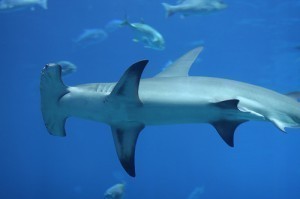How Big is a Hammerhead Shark
The hammerhead shark is one of the highly interesting shark species because of the unique shape and structure of its head.  The hammer-shaped part of the head is scientifically referred to as cephalofoil. This particular part of its body is used for prey manipulation, maneuvering and sensory reception. This particular kind of shark lives in continental shelves and along coastlines where the waters are warmer. Aside from these interesting facts, it is also nice to learn the size of hammerhead sharks.
The hammer-shaped part of the head is scientifically referred to as cephalofoil. This particular part of its body is used for prey manipulation, maneuvering and sensory reception. This particular kind of shark lives in continental shelves and along coastlines where the waters are warmer. Aside from these interesting facts, it is also nice to learn the size of hammerhead sharks.
The Size of Hammerhead Sharks
How big is a hammerhead shark? There are actually nine different species of hammerhead sharks, all of which grow within the range of 3 to 20 feet or 0.9 to 6 meters long. All of their heads resemble a flattened hammer, which set them apart from other shark species. Their uniquely shaped heads allow them to turn sharply while maintaining stability. Likewise, the shape of their heads aids them maneuver and find food.
Additional Facts and Other Highly Important Details
Hammerhead sharks have ampullae of Lorenzini, which are basically electroreceptory sensory pores just like all the other types of sharks out there. Their nostrils are positioned further apart, which help them improve their capacity to identify chemical gradients and find the source. Based on research, there is a strong probability that this kind of shark evolved during the Miocene, Oligocene and late Eocene epochs.
It is classified under kingdom animalia, with chordate as its phylum and chondrichthyes as class. Its subclass is elasmobranchii and its order is carcharhiniformes. Its family is sphyrnidae and its genus sphyrna. When exposed to sunlight, this type of shark has the ability to acquire a tan. Only pigs and humans share the same kind of characteristic.
Some of its most popular species include the whitefin hammerhead, the smooth hammerhead as well as the great hammerhead. Under the subgenus Platysqualus are the smalleye hammerhead, the shovelhead or bonnethead and the scoophead. Under the subgenus Mesozygaena are the winghead shark and the scalloped bonnethead.
Amongst the different species of the hammerhead shark, only three are potentially dangerous to people, namely smooth, the great and the scalloped hammerheads. In 2008, the World Conservation Union released a Red List that includes the scalloped and the great hammerheads as endangered. In the same list, the smalleye hammerhead was listed under the vulnerable animals. The young hammerheads spend a lot of time in shallow waters to avoid different kinds of predators.





